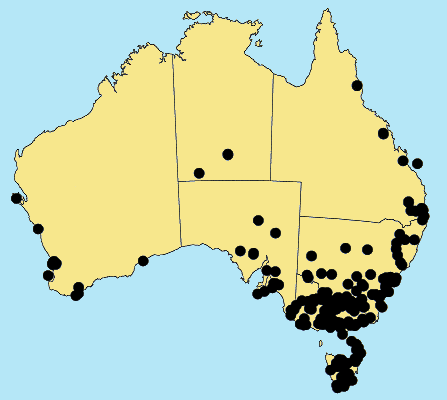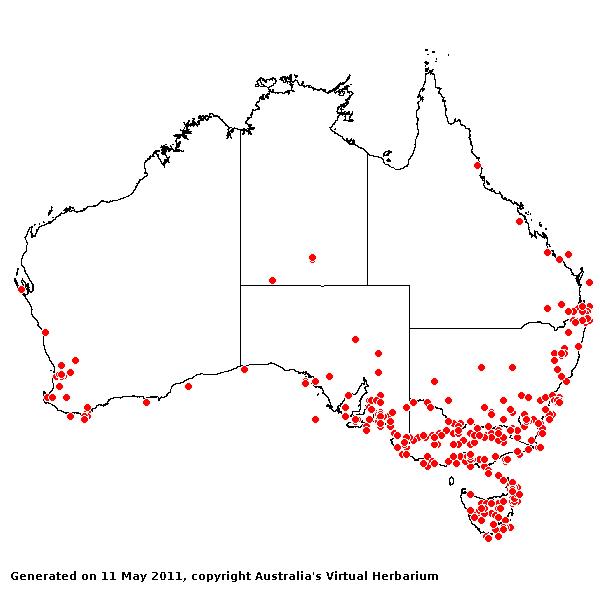Poa annua L. Sp. Pl. 68 (1753).
Classification. (GPWG 2001) : Subfamily Pooideae. Tribe Poeae.
Type of Basionym or
Protologue Information: LT: (LINN-87.17 (right-hand plant)). LT designated
by Soreng in Cafferty et al., Taxon 49(2): 254 (2000); same specimen
indicated with uncertainty as HT by Veldkamp, Blumea 38: 421 (1994).
Key references
(books and floras): [1878] G.Bentham, Flora Australiensis 7 (654),
[1952] C.A.Gardner, Flora of Western Australia 1 Gramineae (106),
[1981] M.Lazarides in J.Jessop (ed)., Flora of Central Australia (431),
[2002] D.Sharp & B.K.Simon, AusGrass, Grasses of Australia, [2002]
J.Wheeler, N.Marchant & M.Lewington, Flora of the South West (430), [2006]
J.Jessop, G.R.M.Dashorst, F.M.James, Grasses of South Australia (145),
[2008] S.W.L.Jacobs, R.D.B.Walley & D.J.B.Wheeler, Grasses of New South
Wales (347), [2009] A.Wilson (ed.). Flora of Australia, Vol 44A. Poaceae
2 (309).
Illustrations:
[2006] J.Jessop, G.R.M.Dashorst, F.M.James, Grasses of South Australia (145, Fig 96), [2008] S.W.L.Jacobs,
R.D.B.Whalley & D.J.B.Wheeler, Grasses of New South Wales, 4th edn
(347), [2009]. A.Wilson (ed.), Flora of Australia 44A: Poaceae 2
(308, Fig. 41).
Habit. Annual.
Culms erect or geniculately ascending or decumbent, stature slender to
delicate, 2–46 cm tall, 2–4 -noded. Mid-culm internodes glabrous. Lateral
branches simple or sparsely branched. Leaves mostly basal or basal and cauline.
Leaf-sheaths smooth. Ligule an eciliate membrane, 0.9–3.4(–5) mm long, truncate
or obtuse. Leaf-blades flat or conduplicate, 0.5–14 cm long, 1–5 mm wide.
Leaf-blade surface smooth, glabrous.
Inflorescence.
Inflorescence compound, a panicle. Panicle pyramidal or ovate, 1–12 cm long.
Spikelets.
Spikelets pedicelled. Fertile spikelets many flowered, with at least 2 fertile
florets (3–4(-10)), comprising 3–4(–10) fertile floret(s), with diminished
florets at the apex, oblong or ovate, laterally compressed, 3–10 mm long.
Glumes. Glumes
similar. Lower glume lanceolate or ovate, membranous, keeled, 1-keeled, 1–3
-nerved. Upper glume elliptic or oblong, 2–3(–4) mm long, membranous, keeled,
1-keeled, 3 -nerved.
Florets.
Fertile lemma 2.5–4 mm long, keeled, 5 -nerved. Lemma surface glabrous or
indumented. Lodicules present. Anthers 3.
Continental
Distribution: Europe, Africa, Temperate Asia, Tropical Asia, Australasia,
Pacific, North America, South America, and Antarctica.
Australian
Distribution: Western Australia, Northern Territory, South Australia,
Queensland, New South Wales, Victoria, Tasmania, Norfolk I, Lord Howe,
Macquarie, Heard.
Western Australia:
Drummond. Northern Territory: Central Australia South. South
Australia: Flinders Ranges, Eyre Peninsula, Northern Lofty, Murray, Yorke
Peninsula, Southern Lofty, South-eastern. Queensland: Cook, Darling
Downs, Moreton, Port Curtis, South Kennedy, Wide Bay. New South Wales:
North Coast, Central Coast, South Coast, Northern Tablelands, Central
Tablelands, Southern Tablelands, Central-Western Slopes, South-Western Slopes,
North-Western Plains, South-Western Plains. Victoria: East Gippsland,
Eastern Highlands, Gippsland Highlands, Gippsland Plain, Grampians, Lowan
Mallee, Midlands, Murray Mallee, Otway Plain, Otway Range, Wilsons Promontory,
Riverina, Snowfields, Volcanic Plain, Wannon, Wimmera. Tasmania:
Furneaux Group, North West, North East, West Coast, Central Highlands,
Midlands, Ben Lomond, East Coast, South West, Mt Field, Mt Wellington.
Notes.
Introduced. Also on Lord Howe Is., Norfolk Is. and Macquarie Is. Native to the
Mediterranean, now widely naturalized. Widespread in a range of habitats,
common as a weed in gardens, pastures and disturbed sites such as roadsides.
Flowers Sept.-Nov. Fruits Sept.-Nov.





